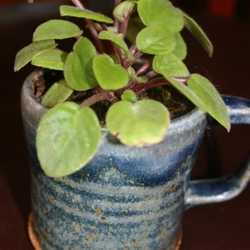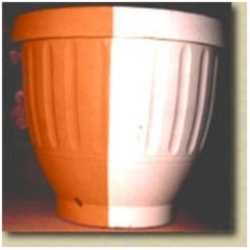Watering Tricks and Tips for container gardening.
It's important to be optimistic. It keeps us from going mad. So whether the glass is half full or equal parts, as long as its not half empty we can find the inspiration for creativity.
Finding something to look forward to when the hot, dry months of summer roll around was challenging. Combining unique ideas from books, friends and family along with my own wit and passion for gardening, I began to look forward to the dry months to see how my watering schedules and plans worked out.
Sometimes container gardening is our only choice. Other times we simply enjoy the aspects of aesthetics in well planted, well decorated pots filled with flourishing blooms and foliage. All growing things need that elixir of life. Water.
Water is sacred in many cultures. As it should be. It truly is the elixir of life.
Watering in containers can be a challenge at any point. But the dry winds of summer can add some extra evaporation to the challenge. Whether it is soil shrinking from the edge of the pot, peat that won't absorb water or top soil that cakes becoming as porous as glass. These tricks can help eliminate part of the battle when it comes to keeping your plants from stressing.
You'll have to think ahead in some cases. When potting up your plants in early spring, be sure to check your soil. Making sure it is comparable with whatever you are planting. Sandy soils for succulents need more watering but less at a time.
It is a common myth that gravel in the bottom of a pot helps with watering.

The common belief is that a layer of gravel in the bottom of pots will improve drainage and keep the soil from spilling out, and besides, that’s how we’ve always done it, so it must be right. Water naturally settles toward the bottom of the soil. But because you’ve partially filled your pot with gravel, that soggy soil bottom is now higher and closer to your plant’s roots. Basically it’s like having a smaller pot. It can cause water to pool, which keeps the roots wet. Leading to root rot. They're heavy too. You can try using crushed aluminum cans or packing peanuts if you are intent on using less soil and it won't weigh 100 pounds. Try using sponges instead. You can save your old dish washing sponges. Cut up some sponges and use that in place of gravel in your pot. Sponges soak up water and prevent it from flushing out the bottom. The roots can drink from the sponges whenever they are thirsty.
Then there is the coil method, which is probably just as old as container gardening itself. The idea is to rely on the capillary action of cotton cloth. Bury a length of cotton cloth in the soil around your plant, coil it gently around the base of the plant, and then drape it into a large bowl of water. As long as the bowl is slightly elevated above the surface of the plant's pot it will slowly wick water down to the roots.
Of course there is the ever popular, dunk your potted plant in a sink full of water trick too. It works well for plants that appear as if a regular watering would not do justice. Or if all that soil shrunk away from the sides of the pot. Simply fill your kitchen sink or other outdoor reservoir with water, and set your potted plant in the water. By the end of the day, your plant should be thoroughly watered. The soil slowly absorbs and expands with the water through out the day.

A friend of mine who recently moved away told me about the diaper trick. She has a one year old daughter and started sharing the pleasures of gardening with her early. If you want to make your soil super absorbent use a clean, un used diaper. The same absorbents that keep your babys bottom free of moisture can hold the moisture in your container plants. Slice open a clean diaper and shake out the contents to mix in with your soil. She also told me about the pencil trick. Knowing your plants water needs is important. Peace lilies and impatiens will let you know immediately they are thirsty. Others are a bit more secretive. Stick a pencil an inch into your soil and pull it out. If dirt sticks to your pencil, you probably don't need to water. This knowledge can help to prevent drowned plants.
Hanging baskets are pretty. But dry out easily, stressing the plants living in it. Three good tricks for keeping a hanging basket watered. One is lining the basket with plastic. Either pot liners or a grocery bag would work. Be sure to poke drainage holes in the bottom of the bag. Lining the pot helps retain moisture by not letting the soil dry out as fast. Another good idea is mulch. Also a preventative of water evaporation, is a good idea for any potted plant. In fact, it's a must for potted plant waterings. Sometimes soil will flush out the bottom over time. Leaving exposed roots. Mulch helps protect the top soil and holds in moisture. If you have a hanging basket in full to partial sun, you can try ice cubes. Put a few ice cubes on top of the soil and walk away. The ice slowly melts, giving the plant a nice cool drink and doesn't run over or spill out the sides. A good way to save time and water.
Potting mix usually has large portions of peat moss. Once dry, it seems unwilling to absorb water. To give thirsty soil incentive to drink, add a drop or two of dish washing liquid to your watering can. The soap will break the surface tension of the water, allowing it to penetrate and soak the dry moss.
My favorite is the slow release reservoir. There are several variations you can adapt. Punch some holes in the bottom of a coffee can and plant it next to your plant, opening side up. The plant will grow around it. Filling the container every few days will let the water slowly penetrate the root zone. Keeping any moisture loving plant happy.

For smaller containers, I use empty glass coke bottles, filled with water and then plunged upside down into the soil. Or you could use plastic soda bottles for better access. Simply cut the bottom off, poke holes in the cap, setting it upside down in the soil next to the roots. Fill occasionally from the hole you cut out of the bottom.
The peace corps encourages farmers in South America to plant pots with their crops. Unglazed terra-cotta pots, especially those with no drainage holes, will sweat water to plant roots around them. Sink the pot to its neck and fill it with water. Depending on how fast the water leeches out, it should provide a steady supply of water to established plants. It's even aesthetically pleasing if you use smaller terra-cotta pots in a larger pot. Gallons of water go to waste by air conditioner run off. Try running a drain line from your A/C to a water thirsty plant nearby.
Another good way to conserve water in container gardening is double potting.
If you have one pot with a plant, place it inside a slightly larger pot. Then fill the gap within the larger pot with soil, top with moss and/or stones and pebbles. When you water, water both the plant and the soil around the first pot. This will lessen evaporation. It's a great alternative for plant watering if you go on vacation or leave the house for an extended period of time.
There are many adaptations one can utilize to save time, money and frustrations when watering your container plants, indoor or out. Hopefully these have given you some inspiration to manage beautiful, bountiful pots full of blooms.
















